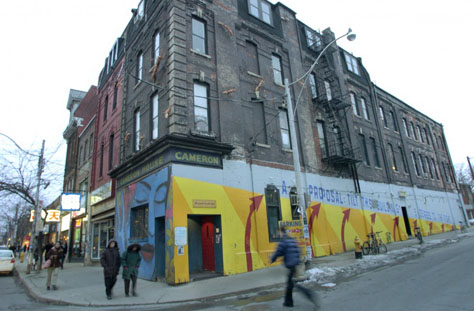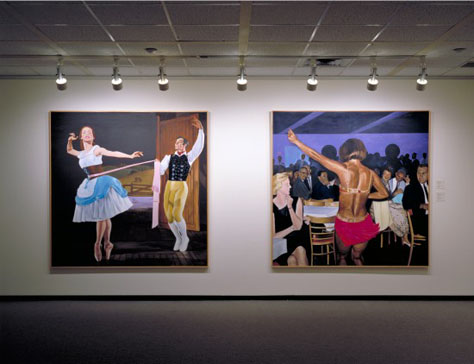
THE GRID - 07 / 20 / 2011
Cameron House Classics
A MOCCA retrospective uncovers the unlikely epicentre of the early-’80s art scene.
—
There was a time when the Cameron Public House was infamous for being one of the city’s most disreputable bars. Indeed, when Herb Tookey and two of his friends purchased the Queen West pub in 1981, it was part business venture and part adventure. As Tookey explains, “I figured we would have a hell of a good ongoing party, especially since there was room for artists and musicians to live upstairs.”
Soon, the Cameron’s second floor—which was originally built as a rooming house—became home to a dozen artists, and the bar began to serve as one of Toronto’s most important cultural incubators. “We got into an art economy,” says Tookey. “We collected creativity instead of cash. We took rent payment in art.”
The fascinating story of how the Cameron became the centre of Toronto’s nascent Queen Street West art scene is at the heart of “This is Paradise | Place as state of mind: The Cameron Public House and 1980’s Toronto,” now showing at the Museum of Contemporary Canadian Art.
Co-curated by Tookey, Rae Johnson and Jonathan Shaughnessy, the exhibition features the work of over 40 artists. It chronicles art in “a decade of boom and bust” as Shaughnessy calls it, “the start of the media age, and the rise of what would now be called post-modernism.” The artists on show were rebelling against values set in post-war North America, while developing strategies to work creatively with television, video and new technologies, like Polaroids and photocopying. Their collective output can be seen as a sort of competition, in which everyone tried, as Johnson says, “to be the most authentic, most hardcore, most ironic, most audacious.”
The show covers only seven years, from 1981 best online casino to 1987, ending when the gentrification of the area began. Tookey summarizes the situation in what’s become a familiar tale: “As the mythology grew, so did the rent, and everybody started moving away.”

Mondo Cana Kama Sutra, 1983, by General Idea
The curators weigh in on some of the highlights from “This is Paradise”:
“In the ’80s, artists began playing the media and working with the idea of becoming art celebrities,” says Shaughnessy. Here, the three-man Toronto art collective General Idea mythologizes themselves as three poodles. “The poodle was the faithful retriever, and the gay companion that you could dress up and take out,” he adds. General Idea—whose Poodle Flag hung briefly outside the Cameron’s front entrance—were among the first to place themselves front and centre in their work.

Purgatorio, A Drinkingbout (Series of Drinkers-Smokey The Bar, No. 2), 1981, by Sandra Meigs
In this work, the smoky bar captures the angst and sociability of the ’80s, and how the club and art scenes converged. Johnson chose to include this drawing because, as she explains, it has the quality of much of the imagery of the era, “with an interest in psychology and the human condition, especially its darker side.”

Having Fun?/The Time of Our Lives, 1984, by Joanne Tod
This painting about stereotypes and our roles as spectators and viewers “is an example of the return of the narrative and figurative to painting in the ’80s,” says Johnson. Compared to the highly conceptual and often austere work of many of the decade’s artists, Tod’s figurative paintings presented a refreshing new direction. Tod also helped paint one of the famous murals on the Cameron’s exterior wall—a street scene of a young woman in a pink and brown varsity jacket hoisting a stubby beer bottle. It was entitled “Artists of the World, Unite.”
This Is Paradise” shows at MOCCA (952 Queen W.) until Aug. 21.